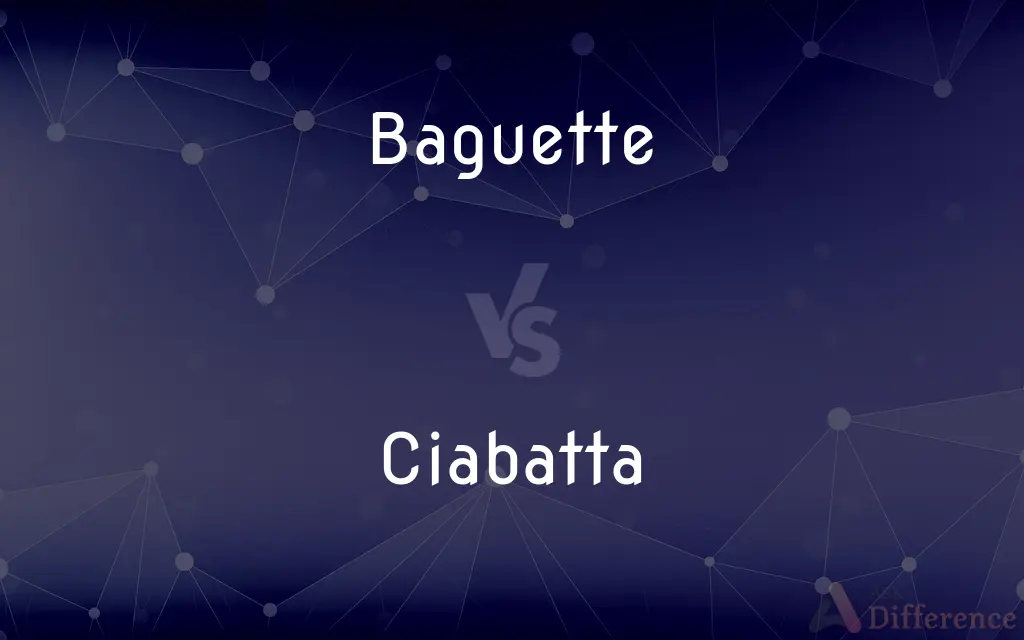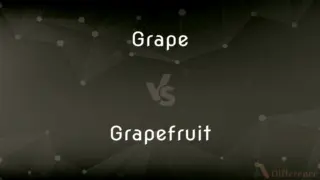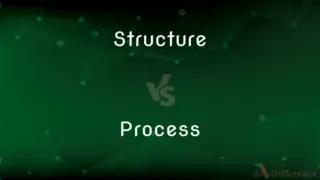Baguette vs. Ciabatta — What's the Difference?
By Fiza Rafique & Urooj Arif — Updated on April 26, 2024
A baguette is a long, thin French bread with a crisp crust and airy interior, while ciabatta is an Italian bread known for its broad, flat shape and porous texture.

Difference Between Baguette and Ciabatta
Table of Contents
ADVERTISEMENT
Key Differences
Baguettes are characterized by their long, narrow shape and a crust that is typically golden and crispy. In contrast, ciabatta bread is often recognized for its broad, flat shape and a more rustic appearance, featuring a flour-dusted crust.
The interior of a baguette is light and airy with a tight crumb, whereas ciabatta has a loose, open crumb with large air pockets, making it ideal for sandwiches.
Baguettes are usually made from a simple lean dough consisting of flour, water, yeast, and salt, leading to a delicate flavor focused on the fermentation notes. On the other hand, ciabatta dough includes olive oil, contributing to a slightly richer flavor and more tender texture.
While baguettes are a staple in French cuisine, often eaten as a side with meals or used for sandwiches like the classic French dip, ciabatta has become popular worldwide for its versatility in a variety of dishes, especially hearty sandwiches that benefit from its sturdier structure.
Comparison Chart
Origin
France
Italy
ADVERTISEMENT
Shape
Long and thin
Broad and flat
Crust
Crispy and golden
Rustic and flour-dusted
Interior Texture
Light and airy with tight crumb
Porous with large air pockets
Dough Composition
Flour, water, yeast, salt
Includes olive oil
Flavor
Delicate, lightly fermented
Richer, tender due to olive oil
Common Uses
French dips, side for meals
Sandwiches, especially hearty ones
Compare with Definitions
Baguette
Made from a simple lean dough.
The baguette dough requires only four ingredients.
Ciabatta
Features a porous texture with large air pockets.
The ciabatta absorbed the olive oil beautifully.
Baguette
Often eaten as part of a traditional French meal.
They served a warm baguette with the soup.
Ciabatta
An Italian bread with a broad, flat shape.
He used ciabatta for the sandwich.
Baguette
A long, thin loaf of French bread.
He sliced the baguette for dinner.
Ciabatta
Ideal for a variety of sandwiches.
She prefers ciabatta for its sturdy structure in sandwiches.
Baguette
Known for its crispy crust and airy interior.
The baguette's crust was perfectly golden.
Ciabatta
Includes olive oil in its dough.
The olive oil gives the ciabatta a tender texture.
Baguette
Used in sandwiches and appetizers.
She made bruschetta with a toasted baguette.
Ciabatta
Popular in rustic and hearty meal settings.
For the picnic, they packed ciabatta sandwiches.
Baguette
A baguette (; French: [baɡɛt] (listen)) is a long, thin type of bread of French origin that is commonly made from basic lean dough (the dough, though not the shape, is defined by French law). It is distinguishable by its length and crisp crust.
Ciabatta
Ciabatta (, Italian: [tʃaˈbatta]; literally "slipper") is an Italian white bread made from wheat flour, water, salt, yeast and olive oil, created in 1982 by a baker in Adria, province of Rovigo, Veneto, Italy, in response to the popularity of French baguettes. Ciabatta is somewhat elongated, broad, and flat, and is baked in many variations, although unique for its alveolar holes.
Baguette
A long, narrow French loaf.
Ciabatta
A porous bread with a crispy crust, baked in a flattish, usually oblong loaf.
Baguette
A gem, especially a diamond, cut in a long rectangular shape
A baguette diamond
Ciabatta
A broad, flat, white Italian bread.
Baguette
A small moulding, semicircular in section.
Baguette
A slim, rectangular handbag with a short strap.
Baguette
A long narrow loaf of French bread.
Baguette
A gem cut in the form of a narrow rectangle.
Baguette
The form of such a gem.
Baguette
(Architecture)A narrow convex molding.
Baguette
A shallow rectangular handbag.
Baguette
A narrow, relatively long rectangular shape.
Baguette
A gem cut in such a shape.
Baguette
A variety of bread that is long and narrow in shape.
Baguette
(architecture) A small molding, like the astragal, but smaller; a bead.
Baguette
(zoology) One of the minute bodies seen in the divided nucleoli of some Infusoria after conjugation.
Baguette
A French person, or a person of French descent.
Baguette
Narrow French stick loaf
Common Curiosities
Why do baguettes have a crispy crust?
The baking technique and dough hydration create a crispy crust.
What are typical toppings or fillings for a ciabatta sandwich?
Meats, cheeses, and vegetables are common.
Can ciabatta be used for French dips like baguettes?
Yes, though its texture is different, it can absorb the jus well.
How long do baguettes and ciabattas last?
Both are best eaten fresh but last for about 2 days when stored properly.
Can I freeze baguettes and ciabattas?
Yes, both freeze well for up to 3 months.
What distinguishes a baguette from ciabatta?
The shape and texture: baguettes are long and thin with a crispy crust; ciabattas are broad and flat with a porous texture.
Is ciabatta healthier than a baguette?
Both are similar, though ciabatta contains olive oil, which adds some fats.
Are baguettes or ciabattas easier to make at home?
Baguettes can be more challenging due to the need for a precise baking technique.
How should I store a baguette to keep it fresh?
Wrap it in a cloth or paper bag, and keep at room temperature.
What makes ciabatta different in texture from other breads?
The high hydration and olive oil create a tender and open crumb.
Is ciabatta suitable for vegans?
Generally yes, but check recipes as some may include dairy.
Share Your Discovery

Previous Comparison
Grape vs. Grapefruit
Next Comparison
Structure vs. ProcessAuthor Spotlight
Written by
Fiza RafiqueFiza Rafique is a skilled content writer at AskDifference.com, where she meticulously refines and enhances written pieces. Drawing from her vast editorial expertise, Fiza ensures clarity, accuracy, and precision in every article. Passionate about language, she continually seeks to elevate the quality of content for readers worldwide.
Co-written by
Urooj ArifUrooj is a skilled content writer at Ask Difference, known for her exceptional ability to simplify complex topics into engaging and informative content. With a passion for research and a flair for clear, concise writing, she consistently delivers articles that resonate with our diverse audience.
















































